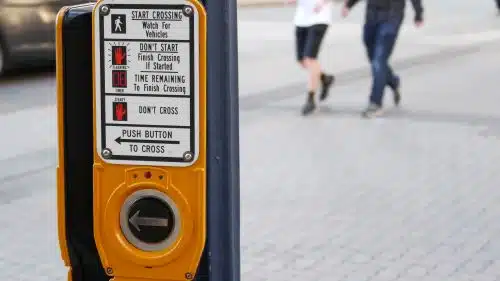
Jaywalking, or crossing the street in a prohibited way, is illegal in North Carolina but is considered a minor infraction and punished with a $100 fine. However, it is dangerous, and if you cause an accident by jaywalking, you could be liable for any injured parties’ expenses.
Many people think that jaywalking involves crossing the street without using a crosswalk, but doing so is technically legal. Under North Carolina law, you only have to use a crosswalk if you are between two adjacent intersections with traffic signals that are working correctly.
In other situations, you may cross the street anywhere you like, but you must yield to traffic. If you don’t yield to vehicles on the road outside of a crosswalk, you would be jaywalking.
What to Do When Involved in a Jaywalking Accident?
If you are driving and strike a jaywalking pedestrian, you should find a place to pull over safely and call 911 to report the accident. Check on the pedestrian to see if they are hurt and request an ambulance if needed.
You should also check yourself and any passengers for injuries, even if people riding in vehicles are less likely to be injured in a car/pedestrian collision.
Take pictures of the accident scene and offer to exchange insurance information with the pedestrian. Even though they were walking, we recommend asking if they have car insurance, which may be important if you need to collect damages.
Avoid arguing with the pedestrian about fault or discussing the cause of the accident. If the pedestrian appears angry or belligerent or is insisting that you are at fault, let them know you’ve called for assistance and end the conversation. It may be a good idea to wait in your car if the pedestrian seems determined to continue the argument.
When the police arrive, they will take statements from you, the pedestrian, any passengers in your car, and any witnesses they notice on the street. Always answer the officer’s questions honestly and to the best of your ability. If you don’t know the answer, just say you don’t know.
Note, however, that you shouldn’t volunteer any information or elaborate beyond what the officer asked and should never speculate about fault. You might not have all the information about what happened, and we’ve met many people who took responsibility for an accident they didn’t cause.
If you feel any pain or have what you believe are minor injuries, it’s essential to let the paramedics check on you. Accidents are very stressful, and sometimes the adrenaline release of a scary experience can suppress pain and other symptoms of serious injury.
Some people don’t have symptoms of their injuries until a few hours or days later, but seeing a doctor as soon as possible will allow you to get prompt treatment. Let the doctor know about your accident and any symptoms you do have so these can be recorded in your medical chart.
If you develop more or worse symptoms later, it will be easier for another physician to treat you.
North Carolina Jaywalking Laws and Personal Injury Claims
Jaywalking laws affect where and how pedestrians can cross the street, but contributory negligence is another important statute to understand when considering a personal injury claim. Many other states base personal injury recoveries on the percentage of fault the injured party or plaintiff has (comparative negligence).
It’s important to know that North Carolina does not allow a plaintiff to recover anything if they contributed to the accident by even a small percentage, such as 1 percent.
What does this mean if you were hit by a car? There’s a good chance the driver and their insurance company will claim that you were somehow at fault in the accident.
One common defense to personal injury lawsuits for pedestrian accidents is that the plaintiff was jaywalking or crossing the road illegally, making them at least partly at fault. The driver may also have been speeding or ignoring other traffic laws, but that won’t matter if you were found to have any amount of fault.
As a result, you must gather enough evidence to prove the driver was completely responsible.
How Can You Prove Fault in a Jaywalking Accident?
The first thing you should do is contact a North Carolina personal injury lawyer. You shouldn’t have to gather evidence yourself while dealing with your injuries. Furthermore, it’s better to have the help of professionals who know what to look for than to search for evidence on your own.
Our investigators have worked on many pedestrian accident cases. They will review the police report before visiting the accident scene to seek more evidence.
Investigators might seek video evidence, find and talk to witnesses, subpoena black box evidence, and more. Our investigators can often uncover additional evidence to prove our client’s case.
What if You Can’t Prove the Driver Was at Fault?
Sometimes, despite an exhaustive search, we cannot locate enough evidence to prove the driver caused the accident exclusively. However, in this situation, we will look for other solutions.
For instance, if the injured pedestrian has MedPay coverage on their car insurance, this policy may take care of their medical expenses. Many people are unaware that their car insurance covers them in pedestrian accidents until they speak with a lawyer.
There may also be other options depending on the specific situation, and your attorney will consider every possibility to help you recover your damages.
Tatum & Atkinson: Hire the Heavy Hitters for Your Pedestrian Accident
At Tatum & Atkinson, we have a proven track record of recovering more than $100 million in damages for our clients. If we take your case, our lawyers, investigators, and support staff will work tirelessly to collect evidence for your claim.
Your initial consultation is free, and we only charge fees once we win or settle your case, so please contact us today at 800-LAW-0804 to learn more.
